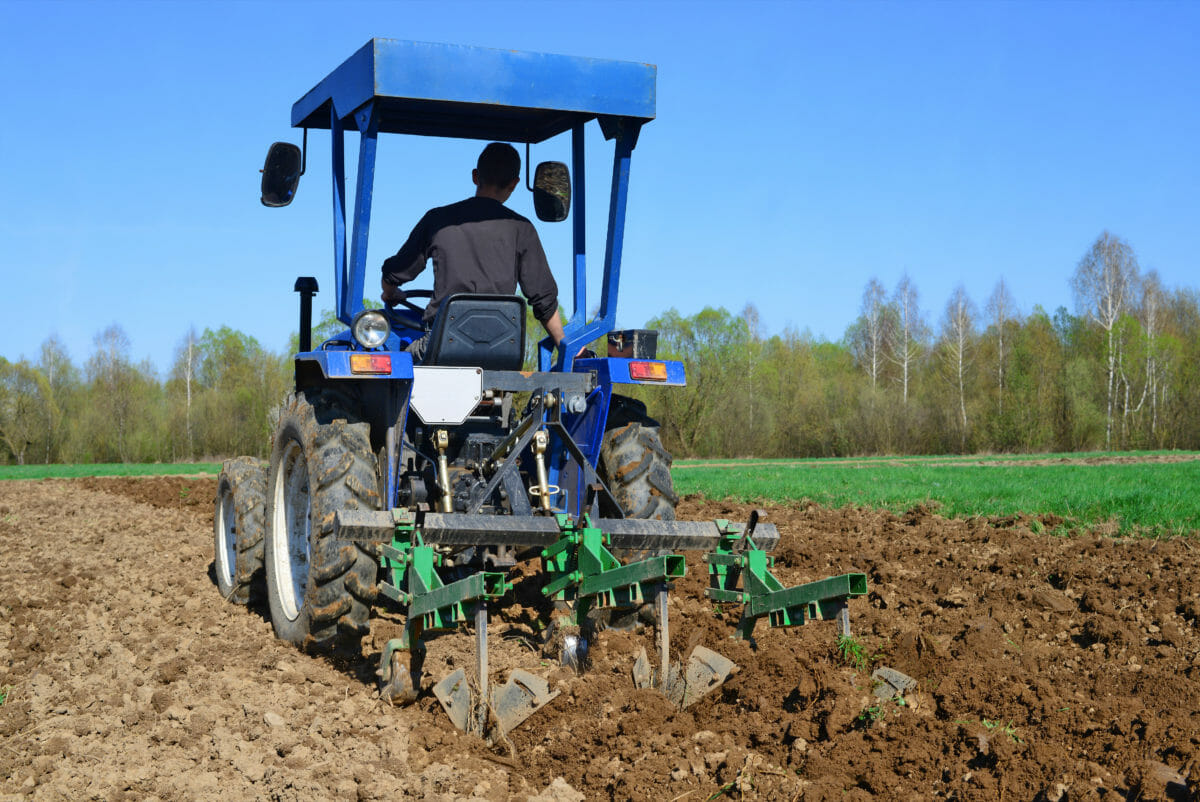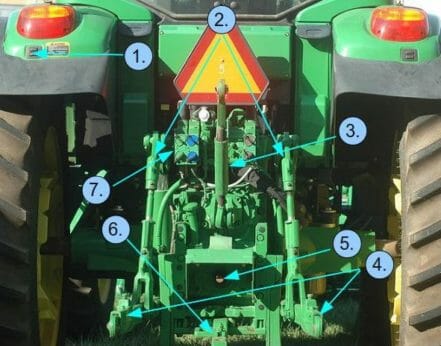Rippers, Hydraulics, and Bush Hogs: The Modern Farmer Dictionary of Tractor Implements
In which you will learn how to use terms like “power takeoff” and “three-point hitch” in a sentence.
Rippers, Hydraulics, and Bush Hogs: The Modern Farmer Dictionary of Tractor Implements
In which you will learn how to use terms like “power takeoff” and “three-point hitch” in a sentence.

A Primer on Hitches
To really show off your farm cred, you need to be fluent in hitch-speak: how implements are attached to tractors, that is. One hundred years ago, the only option was to drag plows and other implements behind a tractor, in the same way that they were dragged behind horses. Things have come a long way.

Drawbar: A horizontal bar bolted to the back of a tractor to which various implements can be mounted. Drawbars were the standard hitch on early tractors, and are still occasionally used today.
Three-Point Hitch: A system with three points of connection, arranged in a triangular layout, between a tractor and an implement. Three-point hitches, which provide greater stability than drawbars and can connect to a much wider range of implements, have been the standard type of tractor hitch since the 1940s.
Hydraulics: Oil-filled, pressurized tubes that power “arms” on the back of a tractor (and often the front) that are used to manipulate implements. Two of the three points of a three-point hitch are typically at the end of hydraulic arms that are used to lower implements to the ground and raise them when not in use.
Power Takeoff: A spinning shaft powered by the tractor engine that is used to turn rotating implements such as mowers and tillers. Power takeoffs, which are typically integrated with a three-point hitch at the rear of a tractor, are notoriously dangerous: many farmers have been maimed or killed when their clothing became caught in the PTO shaft.
Implement Dictionary
Here is a sampling of the tools that can be mounted on the front or back of a tractor. Some require PTO or hydraulic power; others are “ground-driven,” meaning the implement is activated simply by dragging it across the earth. NOTE: Though posthole diggers, stump grinders, backhoes, and snow blowers are fun toys to mount on your John Deere, we’ve left those out in favor of implements that have a direct connection to agriculture.
Bed Shaper: A tool that forms tilled soil into raised beds with furrows between them. Bed shapers are often used before planting vegetables to create deeper, better-drained beds than is possible simply with tilling.
Disk Harrow: A series of round blades that loosen soil, destroy weeds, and chop up crop residue. Disks do not the loosen the soil the depths possible with a tiller or plow but are used for seeding grains and other crops where deep tillage is not required.
Hay Baler: A large implement that forms compressed bales when pulled over rows of dry hay (most balers are PTO-powered). Different balers are used to make small rectangular bales versus large cylindrical bales; the latter requires a larger tractor.
Hay Rake: An implement that pulls hay into rows after it has been dried in the field (both ground-driven and PTO-powered models are available). Raking hay into rows is the intermediate step between tedding, which helps the hay to dry, and baling.
Hay Tedder: An implement with many small spinning tines that fluffs up and turns over freshly cut hay (both ground-driven and PTO-powered models are available). A tedder makes hay dry faster, preventing it from becoming moldy.
Loader: A bucket mounted to the front of a tractor that is used to move compost, soil, brush, livestock feed and other materials around a farm. Loaders, which give tractors capabilities similar to a small bulldozer, are powered by a hydraulic system.
Manure Spreader: A cart pulled behind a tractor in which spinning blades force the contents (manure or compost) out the back (both ground-driven and PTO-powered models are available). Manure spreaders are designed to evenly distribute the material across a field.
Plow: Steel shanks that are pulled behind a tractor to loosen the earth in preparation for planting. The various types of plows – chisel and moldboard are the most common – are old-fashioned cultivation tools that are still widely used; unlike tillers, plows are simply pulled behind a tractor and do not require power from a PTO.
Ripper: A long steel shank (also referred to as a subsoiler) that loosens the soil to a much greater depth than other implements, but does not mix the surface layers of the soil like a tiller. Rippers, which are used to break up “hard pan” soil to improve drainage and allow roots to penetrate more deeply, may be used singly or with several mounted together on a large rack.
Roller Crimper: A large cylindrical implement used to crush existing vegetation (typically a cover crop) in a field so that seed may be planted directly without any other form of tillage or cultivation. Because they do not disturb the soil, roller crimpers are a popular implement on “no-till” farms; they are often mounted on the front of a tractor, while a rear-mounted seed drill simultaneously plants the crop.
Rotary Mower: A PTO-powered mower with thick, dull blades that is used to chop down heavy brush, rather than grass. Popularly referred to as a bush hog (which is a brand of rotary mowers), this maintenance tool is often used to keep pastures from reverting to forest.
Seed Drill: An implement that deposits seeds into the ground and covers them with soil (both ground-driven and PTO-powered models are available). Seed drills are adjustable to accommodate the required planting depth and spacing of different crops.
Sickle Bar Mower: A mower with a blade that extends off to one side of the tractor, making it possible to maintain ditches, pond edges and other areas where it would be unsafe to drive a tractor. Sickle bar mowers, along with disk and drum mowers, are often used to cut hay.
Sprayer: A pressurized tank used to distribute liquid pesticides and fertilizers (both organic or synthetic forms). Sprayers, which are typically PTO-powered, are either mounted on the back of a tractor or pulled on a cart.
Spreader: A hopper with a spinning disk at the bottom that is used to distribute fertilizer or seed evenly across a field. Spreaders, which are typically PTO-powered, are either mounted on the back of a tractor or pulled on a cart.
Spring-Tooth Harrow: Curved blades that break up the surface of the soil to remove weeds and prepare for planting. Spring-tooth harrows are often used as a final stage of tillage to create a fine seedbed.
Tiller: A PTO-powered tool with a series of angled blades that rotate rapidly, loosening soil and destroying weeds in preparation for planting. Tiller blades, also referred to as tines can loosen the soil to a depth of 6 inches or more, which is necessary for planting most vegetables.
Follow us
This work is licensed under a Creative Commons Attribution-NoDerivatives 4.0 International License.
Want to republish a Modern Farmer story?
We are happy for Modern Farmer stories to be shared, and encourage you to republish our articles for your audience. When doing so, we ask that you follow these guidelines:
Please credit us and our writers
For the author byline, please use “Author Name, Modern Farmer.” At the top of our stories, if on the web, please include this text and link: “This story was originally published by Modern Farmer.”
Please make sure to include a link back to either our home page or the article URL.
At the bottom of the story, please include the following text:
“Modern Farmer is a nonprofit initiative dedicated to raising awareness and catalyzing action at the intersection of food, agriculture, and society. Read more at <link>Modern Farmer</link>.”
Use our widget
We’d like to be able to track our stories, so we ask that if you republish our content, you do so using our widget (located on the left hand side of the article). The HTML code has a built-in tracker that tells us the data and domain where the story was published, as well as view counts.
Check the image requirements
It’s your responsibility to confirm you're licensed to republish images in our articles. Some images, such as those from commercial providers, don't allow their images to be republished without permission or payment. Copyright terms are generally listed in the image caption and attribution. You are welcome to omit our images or substitute with your own. Charts and interactive graphics follow the same rules.
Don’t change too much. Or, ask us first.
Articles must be republished in their entirety. It’s okay to change references to time (“today” to “yesterday”) or location (“Iowa City, IA” to “here”). But please keep everything else the same.
If you feel strongly that a more material edit needs to be made, get in touch with us at [email protected]. We’re happy to discuss it with the original author, but we must have prior approval for changes before publication.
Special cases
Extracts. You may run the first few lines or paragraphs of the article and then say: “Read the full article at Modern Farmer” with a link back to the original article.
Quotes. You may quote authors provided you include a link back to the article URL.
Translations. These require writer approval. To inquire about translation of a Modern Farmer article, contact us at [email protected]
Signed consent / copyright release forms. These are not required, provided you are following these guidelines.
Print. Articles can be republished in print under these same rules, with the exception that you do not need to include the links.
Tag us
When sharing the story on social media, please tag us using the following: - Twitter (@ModFarm) - Facebook (@ModernFarmerMedia) - Instagram (@modfarm)
Use our content respectfully
Modern Farmer is a nonprofit and as such we share our content for free and in good faith in order to reach new audiences. Respectfully,
No selling ads against our stories. It’s okay to put our stories on pages with ads.
Don’t republish our material wholesale, or automatically; you need to select stories to be republished individually.
You have no rights to sell, license, syndicate, or otherwise represent yourself as the authorized owner of our material to any third parties. This means that you cannot actively publish or submit our work for syndication to third party platforms or apps like Apple News or Google News. We understand that publishers cannot fully control when certain third parties automatically summarize or crawl content from publishers’ own sites.
Keep in touch
We want to hear from you if you love Modern Farmer content, have a collaboration idea, or anything else to share. As a nonprofit outlet, we work in service of our community and are always open to comments, feedback, and ideas. Contact us at [email protected].by Brian Barth, Modern Farmer
July 31, 2018
Modern Farmer Weekly
Solutions Hub
Innovations, ideas and inspiration. Actionable solutions for a resilient food system.
ExploreExplore other topics
Share With Us
We want to hear from Modern Farmer readers who have thoughtful commentary, actionable solutions, or helpful ideas to share.
SubmitNecessary cookies are absolutely essential for the website to function properly. This category only includes cookies that ensures basic functionalities and security features of the website. These cookies do not store any personal information.
Any cookies that may not be particularly necessary for the website to function and are used specifically to collect user personal data via analytics, ads, other embedded contents are termed as non-necessary cookies.
Agriculture